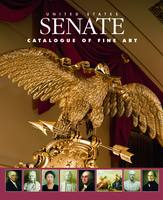 |
The United States Capitol is recognized around the world both as a symbol of our country and for the momentous events that have taken place there. However, the building’s interior is far less well known. Visitors are often surprised by the Capitol's stunning architectural details and the impressive art complementing the interior spaces. Now, those works of art–ranging from portraits of prominent senators to depictions of significant events in U.S. history–are accessible to everyone through the publication of the United States Senate Catalogue of Fine Art. Prepared by the Office of Senate Curator, the catalogue represents the first comprehensive effort to illustrate and interpret this rich collection of paintings and sculpture.
The United States Senate Catalogue of Fine Art highlights 160 works of art, including 82 sculptures, 75 paintings, 2 enameled mosaics, and 1 stained glass window. Each work is illustrated with a color photograph and accompanied by essays and secondary images that place the work in historical and aesthetic context. These secondary images include other works of art that inspired or served as a model for the work in the Senate collection, as well as photographs that display the art in its current location. There is also an introductory essay that analyzes the art in the Senate and its place in American art history.
The catalogue is a result of a lengthy tradition of art in the Senate, a tradition that primarily dates from the establishment of the Joint Committee on the Library in 1802. In addition to maintaining the Library of Congress, this committee was also responsible for supervising the acquisition of art for the Capitol, the White House, and the public squares of Washington, D.C. After the middle of the nineteenth century, the joint committee became especially active in the selection of sculpture and painting. When the Capitol was expanded by adding the new dome and two new chambers for the legislature, a campaign was undertaken to decorate the building to reflect the United States’s newfound importance in world affairs.
Over the years, the Senate’s art collection has taken shape through several means. Some pieces have been purchased and others specially commissioned. Donors have also offered important works of historical significance that have become welcomed additions to the collection.
A review of the catalogue illustrates the broad sweep of U.S. history and the diversity of the Senate’s art collection. The 160 pieces in the catalogue represent the work of 111 artists, including such celebrated figures as Gilbert Stuart, Alexander Calder, Augustus Saint-Gaudens, Thomas Sully, and Daniel Chester French. Many of the works feature prominent senators, including portraits of Everett McKinley Dirksen, Mike Mansfield
, and Robert A. Taft, and small bronze sculptures of Henry Clay and Daniel Webster. Many of the subjects are immediately recognizable; there are depictions of George Washington, Thomas Jefferson, Theodore Roosevelt, and Benjamin Franklin. Lesser-known figures include the Native American chief Be sheekee and Senate employee
Isaac Bassett, who came to the Senate in 1831 as one of the first pages and stayed until 1895, when he was an elderly doorkeeper. Although portraits dominate the collection, the American landscape is represented by an oil painting of Niagara Falls in winter. Major events are also documented, such as the first reading of the Emancipation Proclamation by President Abraham Lincoln and the first manned moon landing. There are two special collections: a series of paintings of major U.S. army posts completed by Seth Eastman between 1870 and 1875, and a collection of
vice presidential busts.
In the catalogue’s introductory essay, art historian William Kloss points to the Senate’s art collection as a “paradigm of public art in the United States,” saying that the collection “was intended to serve a grander purpose . . . to commit to posterity the persons and events of our national history, centered upon the institution of the Senate and on the founding of the Republic.” The United States Senate Catalogue of Fine Art offers readers an opportunity to see how this purpose was met.
The catalogue is available online through the Government Printing Office (GPO). It can be purchased from the Senate Gift Shop in the Dirksen Senate Office Building or the GPO bookstore. The catalogue may also be available at a federal depository library in your state.